Authors
IGNITING DARKNESS–Coming June 2, 2020
Hoping to find an ally from the convent, Sybella instead discovers yet another initiate who has been misled and misused by the former abbess of Saint Mortain. But with long held secrets exposed and allegiances revealed, Sybella must form an uneasy trust borne of desperation to combat enemies at the French court who would have them branded as traitors and heretics.

Some mistakes cannot be fixed—that is Genevieve’s growing fear. Though she may have been a fool, she is no coward and will do whatever it takes to set things right and ensure her Queen’s—and Sybella’s—safety. It will take all of Genevieve’s strength of will and cunning, along with Sybella’s willingness to embrace her growing power. But even that may not be enough.

Plans fail, fragile loyalties are tested, and bridges burn in this riveting conclusion to the Courting Darkness duology. Here, the Daughters of Death finally embrace the full depth of their power—and try to make whole that which has been broken, including themselves.
Want to read more? You’re in luck! My publisher is providing an e-sampler of the first eleven chapters. I hope you have as much fun reading it as I did writing it! (And if you get so excited that you feel like pre-ordering the book–be sure to save your receipts! There will be a pre-order gift. Details coming soon!)
The epic ending to an epic adventure! THE ONCE KING comes out today!

Leylia’s secret could unite them all or lead them to an eternity of undeath. After the loss of Bastion, everyone who’s not a zombie has holed up in FFO’s sole remaining safe haven: the lowbie town of Windy Lake. But the undead armies never rest, and it’s only a matter of time before the Once King’s forces come to crush what’s left of life in this world. But Tina, James, and the rest of the players are facing a crisis of their own. After so long in this world, their human bodies are dying on the other side. If they don’t find a way home soon, they may have nothing to go back to. With time running out in two worlds, Tina and James face a horrible choice: do they spend their final days looking for a way to get back to their old bodies, or join the NPCs to fight for their new ones. But just when things look impossible, James learns a secret that might change everything. Only one catch: to pull it off, they’re going to have to fight one raid boss no one, not even Tina, has ever beaten. The Once King. Get your copy now in ebook, Kindle Unlimited, or Audible audio! All adventures have to end sometime, but wow, have we got an ending for you! The final book in the Forever Fantasy Online trilogy, THE ONCE KING, is out today in ebook and Audible audio edition! HOORAY!
What is SB hiding? What did Leylia tell James? Can the Once King even be beaten? Just how OP are Stonekin anyway?!?! I hope you're ready to find out, because we are at max DPS, baby! (Details per second.)
Terrible jokes aside, it's been a hell of a ride! Travis and I can't say how proud and happy we are to finally give you the book we wrote this whole series to reach. THE ONCE KING is my personal favorite of the trilogy, and I really hope it will be yours too! Thank you so so much for reading and listening, and we both hope you love the story!
(And if you haven't read the FFO series yet, now's a great day to start! Pick up the first novel in ebook, audio, or on KU and see what all the hype is about! Even if you're not a gamer, I promise you won't be disappointed!)
Thank you for being the best fans ever, and I'll see you soon for the final DFZ book, coming early next year! Keep reading!
Yours always,
Rachel Aaron and Travis Bach Hoarders of Epic Loot
THE ONCE KING is the third book in the FFO trilogy. If you're new, start from the beginning with FOREVER FANTASY ONLINE for some GamerLit that's actually lit!
Start up the final boss music! FFO 3 is coming November 12!

Leylia’s secret could unite them or lead them to an eternity of undeath.
After the loss of Bastion, everyone who’s not a zombie has holed up in FFO’s sole remaining safe haven: the lowbie town of Windy Lake. But the undead armies never rest, and it’s only a matter of time before the Once King’s forces come to crush what’s left of life in this world. But Tina, James, and the rest of the players are facing a crisis of their own. After so long in this world, their human bodies are dying on the other side. If they don’t find a way home soon, they may have nothing to go back to. With time running out in two worlds, Tina and James face a horrible choice: do they spend their final days looking for a way to get back to their old bodies, or join the NPCs to fight for their new ones. But just when things look impossible, James learns a secret that might change everything. Only one catch: to pull it off, they’re going to have to fight one raid boss no one, not even Tina, has ever beaten. The Once King. Pre-order your copy now!
I know it took forever, but the third and final Forever Fantasy Online book is finished and coming out in audio and ebook on November 12!
I hope you're ready for answers and boss fights, because wow did we pack a lot into this book! Travis and I are both super happy with how we ended the series, and we can't wait (CAN'T WAIT) for you all to read it!
As you can see, the ebook is already up for preorder, but the audio edition should be releasing on November 12 too! Print is in the works as well, so whatever version you like, you'll get! Thank you to everyone for sticking with us through this crazy love letter to MMOs, and we really hope you enjoy THE ONCE KING!
See you again on launch day, and until then, keep the DPS high!
Yours always,
Rachel Aaron and Travis Bach Keepers of DKP Benevolent Loot Council
THE ONCE KING is the third and final book in the FFO series. If you're new, start from the beginning with FOREVER FANTASY ONLINE. We promise you won't be sorry!
PART-TIME GODS is out in audio!
 Life in the magical mess of the Detroit Free Zone is never easy. When you're laboring under the curse of a certain prideful, overbearing dragon, it can be down right impossible.
My name is Opal Yong-ae, and I'm a Cleaner. Thanks to the supernatural bad luck that turns everything I do against me though, these days I'm more of a walking disaster. Getting rid of this curse is the only way to get my life back. Unfortunately, dragon magic is every bit as sneaky and deadly as the monsters behind it, and just as hard to beat.
But I've never been one to take her doom at face value. Cornered doesn't mean defeated, and in an awakened city that rules herself, dragons are no longer the biggest powers around.
Get your copy now on Amazon or straight from Audible.com!
Life in the magical mess of the Detroit Free Zone is never easy. When you're laboring under the curse of a certain prideful, overbearing dragon, it can be down right impossible.
My name is Opal Yong-ae, and I'm a Cleaner. Thanks to the supernatural bad luck that turns everything I do against me though, these days I'm more of a walking disaster. Getting rid of this curse is the only way to get my life back. Unfortunately, dragon magic is every bit as sneaky and deadly as the monsters behind it, and just as hard to beat.
But I've never been one to take her doom at face value. Cornered doesn't mean defeated, and in an awakened city that rules herself, dragons are no longer the biggest powers around.
Get your copy now on Amazon or straight from Audible.com!
My narrator Emily Woo Zeller did an amazing job as always. Also, if you already bought the ebook, the audio edition is only $7.49 on Amazon, which is a steal. It's a great production, and I really hope you'll give it a try! Thank you as always for being my readers/listeners, and I hope you love this next chapter in Opal's story! Yours always, Rachel
Surprise! The sequel to MINIMUM WAGE MAGIC is out today!
 Ta daaaa!
Ta daaaa!
No, this isn't a cover reveal or a pre-order announcement. The second DFZ novel, PART-TIME GODS, is legit out. Right now. Today.
Check the blurb:
Life in the magical mess of the Detroit Free Zone is never easy. When you’re laboring under the curse of a certain prideful, overbearing dragon, it can be down right impossible. My name is Opal Yong-ae, and I’m a Cleaner. At least, I used to be. Thanks to the supernatural bad luck that turns everything I do against me, these days I’m more of a walking disaster. Getting rid of this curse is the only way to get my life back. Unfortunately, dragon magic is every bit as sneaky and deadly the monsters behind it, and just as hard to beat. But I’ve never been one to take her doom at face value. Cornered doesn’t mean defeated, and in an awakened city that rules herself, dragons are no longer the biggest powers around. Get your copy now in ebook and Kindle Unlimited!
So why the surprise drop? Well, if you follow me on Twitter, you already know that our entire family just up and moved from Georgia to Colorado! It was a super happy adventure, but, as with all good adventures, the rest of my life kind of fell apart during the move, including the launch schedule for this book.
-_-
But I wasn't going to let a small thing like my entire life being in boxes keep a sequel from you guys! PART-TIME GODS was ready to go, so I said screw it, we'll do it live! Just think of this as my own, much smaller, much less organized version of a Beyonce Lemonade drop. Happy summer of books, everyone!
EDIT: AUDIO BOOK UPDATE!! Wow, you guys love audio books! The outcry for an audio release date has been fierce, and I don't blame you a bit! I just heard back from Audible that the production schedule for DFZ 2 was actually delayed due to schedule conflicts with my narrator, Emily, and I was never informed.
Oh well, mistakes happen, but the good news is that I've confirmed the audio edition will come out on July 2, 2019! That's less than a month away!! Not what I wanted, obviously, but it's not too bad.
In the meanwhile, the book is out in KU and ebook right now! I hope you love this surprise trip into the DFZ as much as I loved writing it, which was a LOT. It's a super fun sequel, and I can't wait for you to read it!!
As ever thank you SO MUCH for being part of my crazy dragon world. I couldn't do any of this without you! Thank you for your patience, and I hope you enjoy PART-TIME GODS!
Yours with many books,
Rachel Aaron High Priestess of Detroit DFZ Clean-up Crew
PART-TIME GODS is the second book in the DFZ series, which is set in the same universe as my Heartstrikers books. If you're new, start from the beginning with NICE DRAGONS FINISH LAST or MINIMUM WAGE MAGIC. I promise you won't be sorry!
LAST BASTION is out today!

The sequel to our gamer novel FOREVER FANTASY ONLINE is here! LAST BASTION comes out TODAY in ebook and audio!
Bastion was supposed to mean safety. It was supposed to mean a break from fighting for their lives and a chance to talk to someone who might actually know what’s going on. Access to their gold and some beer would have been nice, too. They got none of those things. When Tina and James arrive in the capital, they find a city on fire in more ways than one. Players and non-players hunt each other in the streets, while the king who controls the city’s all-powerful artifact cowers from the chaos in his castle. Desperate to warn somebody about the Once King’s coming invasion, James wants to try to talk to the king anyway, while Tina just wants to meet the royal portal keepers who might be able to send them home. It shouldn’t be hard to get an army of the world’s best-geared players through one city, but when they discover that the captain of the Royal Knights has been massacring low-level players in revenge disguised as justice, James and Tina will have to decide what is more important: the lives of their fellow gamers, or the stability of this world’s last great city. Both choices deserve a champion, but with the Once King’s armies closing in, taking the wrong side may doom everyone to an eternity as slaves to the Ghostfire. Get your copy now! Only $4.99 or free for Kindle Unlimited subscribers!
It's almost summer, and you know what that means! Rachel and Travis release books!!
We've got a whole lot of awesome coming for y'all in 2019, and to kick it off, today's the day the long awaited (and just long in general) sequel to our first gamer novel FOREVER FANTASY ONLINE is finally released to the world! LAST BASTION is out right now in both ebook and audio format!
As always, print editions are lagging a little behind. We're in the process of moving both our print production company and our actual house, so things are chaos, but I promise you print is coming for both FFO and my DFZ series. And speaking of the DFZ, the sequel to MINIMUM WAGE MAGIC should be out this summer as well! It's a summer of books!!
My New Release mailing list is always the first to know when the release date goes up, so if you're not already a subscriber, sign up now and be cool! It's free, I only mail you when a book is coming out, and you get a list exclusive Heartstrikers short story. It's win all around!
Anyway, we really hope you love LAST BASTION! And for those of you who haven't given our gamer novels a try, I hope you'll change your mind. It's basically a Fantasy epic with modern characters and a whole lot of action and drama. Also, both books are available for free to Kindle Unlimited subscribers, so I hope you'll give book 1 a go. I promise you wont' be disappointed!
As always, thank you so so much for being our readers! You folks are the ones who make the magic possible, and we can't thank you enough. Travis and I hope you enjoy LAST BASTION, and I really can't wait to announce the next DFZ book!
Thank you again, and we'll see you soon!
Yours always,
Rachel Aaron and Travis Bach Spawn Camping Loot Hoarders Opportunistic Treasure Enthusiasts
LAST BASTION is the second book in the FFO series. If you're new, start from the beginning with FOREVER FANTASY ONLINE! I promise you won't be sorry!
The Charbonnerie and the Dark Mother
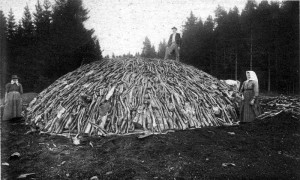 As I wrote Dark Triumph, I wanted to be sure and populate the book with some of the colorful characters from the Middle Ages that I had come across in my research, and yet it had to feel organic to the story and not wedged in there.
As I wrote Dark Triumph, I wanted to be sure and populate the book with some of the colorful characters from the Middle Ages that I had come across in my research, and yet it had to feel organic to the story and not wedged in there.
As Sybella and the wounded knight were racing through the countryside, trying to escape pursuit, I had to do some serious thinking as to who they would actually run in to, and of those people, who would help, who would hinder, and who would turn them in in a heartbeat for a reward. Since they would need to slip into the forest to evade capture, I decided to draw from those who lived in the forests or obtained their livelihood from the woods, and settled upon a group of charcoal burners.
Oddly, it is often the outcasts in society who are most accepting of other outcasts. Their very disenfranchisement sometimes makes them more willing to challenge the status quo or thumb their nose at rigid authority. While charcoal burners were not (probably) true outcasts, they did keep to themselves somewhat, confined by their livelihood to dwelling in forests and tending their charcoal fires rather than living in cities or villages.
In the middle ages, one of the most efficient fuels at the time was charcoal. Coal itself was rare and difficult to mine with their technology, but charcoal could be made through the slow burning of wood, then stopping the process before the wood was fully burned to ash. Charcoal burning was a tricky thing, requiring fairly esoteric knowledge of how to build the fire pits just so, how to pile the wood so it wouldn’t burn too quickly, and how to read the smoke to discern when the charcoal was ready. There were a number of occupational hazards, primarily involving collapsed fire pits and burns. It was also an occupation full of hazard, for a stray spark or ember could start a conflagration in minutes.
As I continued to research charcoal burners, I came across a curious mention of the Carbonnari, a branch of Italian charcoal burners. They started off as a guild, as many medieval trades did, and developed into an organization or brotherhood similar to Freemansons, only with their charcoal burning trade being at the center of their rituals and organizations. While their organization and political involvement was most evident in 19th century Italy, it is believed the groups’ origins began in the middle ages. When I learned they had a French counterpart called the Charbonnerie, I knew I’d found my outcasts.
As a writer, a dozen questions immediately went off in my mind. Who were they? What would compel them to become political and engage themselves in the affairs of the kingdom? How would they make those decisions? And, most importantly in a world populated with patron saints, whom would they worship?
Any deviation from normal church doctrine in the middle ages was rigorously opposed, so it made sense to me that they would worship someone not approved by the church, one of the older gods who’d not make the transition to patron saint.
Dovetailing nicely with this was my personal fascination with the concept of the Black Madonna. There are various theories for the origin of the Black Madonna, whether it was simply the color of Jesus and Mary’s skin before Renaissance artists reimagined them as fair skinned and blonde, or an origin that spoke to possible African roots. There is some speculation that the huge popularity of the cult of the Virgin Mary in the middle ages was a redirecting of earlier earth/mother goddess worship.
But interestingly, over the years I’d also run into mentions of the Black Artemis, rumored to have been worshipped by the Amazons, or Black Demeter, the aspect of the earth goddess when she was in deep mourning for her daughter Persephone. I took all those threads and swirled them around until I had the Dark Matrona, the unsanctioned aspect of Dea Matrona, the former earth goddess now patron saint. I decided that her darkness would be of a more spiritual nature, not unlike the Egyptian god Osiris, for in the Egyptian pantheon, black was not only the color of the underworld, but regeneration as the rich dark silt from the Nile river allowed them to grow their crops each year, and so black was also the color of regeneration, which dovetailed nicely with the book’s themes of finding hope in the darkness.
HFA Refresher: The Mythology of the Nine
While the Nine Old Gods of Brittany are my own invention, they were built on a number of historical, geographical, and ancient theological precedents, so I thought I’d share some of those here for those of you who are curious to know what my inspirations for world of His Fair Assassin were.
As the Catholic Church struggled to gain acceptance among people who were reluctant to let go of their own pagan beliefs, it made a conscious decision to actively subsume those beliefs into Christianity, white washing and Christianizing them along the way. They felt it would make it easier for people to accept the new religion if they could recognize parts of their old beliefs in it.
Brittany was also home to the last remaining group of druidesses, called the Gallinezae, who were said to possess mysterious power. Additionally, Brittany had nine bishoprics, or districts, that were based on the nine earlier Celtic tribes who inhabited the land.
Since Brittany was originally inhabited by the Celtic tribes, I built the mythology of His Fair Assassin on a Celtic foundation. It’s also important to note that I drew from Continental Celtic roots for my mythology rather than the Irish Celts.
Trying to accurately recreate any Celtic beliefs is tricky however, because the Celts themselves did not create any written record of their beliefs or practices; it was all passed along through the oral tradition. In fact, druids in training were required to study for twenty years in order to learn all their lore and history by committing it to memory.
Consequently, nothing of the Celtic religion or spiritual beliefs and practices was written down until they were invaded by Rome. In addition to viewing the Celts practices with scorn, the Romans often interpreted other pantheons according to their own, thus a mother goddess must be equated with Zeus’s wife Hera, or a god of the Underworld with Hades, etc. This Interpretatio romana colored everything we knew about Celtic practices up until fairly recently when improved archaeological techniques and methods began revealing a more complete and accurate picture. The funny thing is though, by the middle ages the myth and folklore of these earlier Celts would have been very much written over and ‘tainted’ by the Romanization of those myths, so that those living in the 15th century would have been more familiar with this Romanized version. Since I set the story in that timeframe, I wanted to be true to that worldview rather than our own, more knowledgeable one.
Here is a list of the Nine Old Gods of Brittany along with their Roman/Greek or Celtic influences/inspiration:
Saint Mortain – god of death. The Celtic equivalent to Dis Pater, the Romanized Celtic god of death, with some similarities to the Welsh Arawn. Greek and Roman counterparts would be Pluto and Hades, but the Celtic Dis Pater had other aspects to him that tied him to older beliefs that enveloped not only the underworld, but the entire cycle of life and death. Also inspired by the Breton figure of personified death, the Ankou.
Dea Matrona – Gaulish mother goddess, responsible for the earth’s bounty. Similar to the Celtic Anu or Ana.
Saint Amourna – daughter of Dea Matrona and one of the twin goddesses of love. Amourna is the gentle aspect of love. The Celtic pantheon had no goddess of love per se, so she definitely has aspects of Aphrodite or Venus. However, the idea of twin sister goddesses representing the dual aspects of love was my own invention.
Saint Arduinna – daughter of Dea Matrona and goddess of love’s sharp bite, protector of virgins. There was a Celtic goddess Arduinna who was a goddess of the forest. Boars, highly revered by the Celts, were sacred to her. Similar to the Gallo-Roman Diana.
Saint Mer – goddess of the sea. While there is no known Celtic god of the sea, there were many deities of springs and lakes, most of whom were goddesses so I decided to make the deity of the sea in my world in keeping with the feminine representations the Celts seemed to favor.
Saint Camulos – god of battle and warriors. Wears a corona of oak leaves and ram’s horns. The Romans equated him with Mars, but I also drew slightly on the cult of Mithros.
Saint Brigantia – goddess of wisdom; brought medicine and healing knowledge to mankind. Based on the Celtic goddess Bridget, who is one of the most widely known pagan goddesses to have become a saint. Her Greek and Roman counterparts would be Athena and Minerva.
Saint Cissonius – god of crossroads and travelers. I took the Celtic Cissonius, god of trade, and expanded on it a bit.
Saint Salonius – god of mistakes and patron saint of bastards. Ah, this is my most historically tenuous god. I have always been a fan of the trickster god who appears in so many pantheons, and I saw a fleeting entry on the Wikipedia Celtic Gods and Goddesses page that reference Salonius, god of mistakes. Alas, when I later went to reference it, the entry was gone and I couldn’t even find it in the Google cache search. Although it seems fitting that my god of mistakes might have been born of one of my own.
HFA Refresher: Anne of Brittany
 Anne of Brittany was a real historic person. At twelve years old, upon the death of her father, she inherited one of the last remaining duchies in Western Europe. By all accounts, she was a remarkable girl. Groomed since birth to inherit the duchy, she was reading and speaking Greek and Latin by the time she was five years old.
Anne of Brittany was a real historic person. At twelve years old, upon the death of her father, she inherited one of the last remaining duchies in Western Europe. By all accounts, she was a remarkable girl. Groomed since birth to inherit the duchy, she was reading and speaking Greek and Latin by the time she was five years old.
Her substantial inheritance was complicated by two things. One, she was a woman at a time when traditionally women did not inherit kingdoms. Since the time of Charlemagne, Salic Law had been invoked to prevent women from becoming rulers. When Anne became Duchess of Brittany, it defied all the conventions of that time. Secondly, and perhaps more importantly, not only was she unmarried, but her father had promised her hand in marriage to at least half a dozen European nobles, if not more. As he plotted and strategized, trying to keep his lands and title safe from the French Crown, he dangled his daughter (and her substantial dowry) as bait for the aid he needed from other princes and dukes. Consequently, when he died, she had been promised to more than one suitor.
To say that this created problems for her in keeping her duchy independent is an understatement. Which is why she needed the help of assassin nuns. What? Doesn’t everybody call for assassin nuns when they’re having political difficulty? If not, they should….
HFA Refresher: Legends of Brittany
In preparation for the publication of COURTING DARKNESS, and because I realize not everyone has time for a re-read of the original trilogy, I thought I would put up some “refresher” posts to help readers reacquaint themselves with the His Fair Assassin world before diving back in. First up: the legends and folklore of Brittany that planted those first seeds in my imagination, lo those many years ago . . .
As I combed through history, looking for the perfect setting for this story, four things caught my attention and eventually solidified into the world of His Fair Assassin. The first was a twelve year old duchess who inherited a kingdom, that inheritance hugely complicated by the fact that she had been promised in marriage to half a dozen princes and nobles.
Next was a mention of the Gallizenae, nine druidesses who lived on the Ile de Sein off the coast of Brittany and possessed mysterious powers.
While Googling for images of the Ile de Sein, I came across of photo of a small, medieval chapel standing next to one of the old, pagan standing stones that are so plentiful in Brittany. It was such a vivid illustration of one of the things that has always fascinated me—how the Catholic Church was so successful at absorbing bits and pieces of the older, ancient religions.
I also learned of a Breton folklore figure call the Ankou, a personification figure of Death.
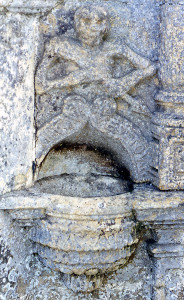
Then lastly, I read about the Passage de l’Enfer—a Breton folktale of fisherman who receive a knock on their door at midnight and were required row the souls of the dead across the ocean at night. Those legends soon became intertwined in my mind and the story idea began to take shape . . .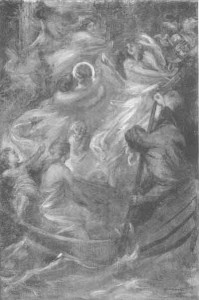
FAQ: Do I Need To Read The HFA Trilogy Before Reading Courting Darkness?
I get asked this a lot, so thought I’d try to address it here.
Courting Darkness is meant to be able to be read without having read the original His Fair Assassin trilogy. But it is not the first book of Sybella’s adventures.
If you read an ARC and were lost—I’m sorry. That is one of the absolute downsides to ARCs—they are unfinished and sometimes relatively unpolished copies. I made THREE more rounds of line edits after the ARCs were printed. A large portion of those changes were to help make Courting Darkness more accessible to new readers and help bring former His Fair Assassin readers up to speed.
I think we succeeded in making it less confusing to new readers. But part of that depends on what sort of reader you are.
Some readers hate to read reviews or synopsis and love trying to piece together the backstory from context clues. Others like every detail spelled out and like a lot of explanation in the narrative. There are definitely readers who hit Courting Darkness cold and thoroughly enjoyed it! Where exactly their reader preferences fell on the above spectrum, I’m not sure.
Part of the problem as a writer was finding a way to revisit the events of Dark Triumph without utterly violating who Sybella is as a character. She is an extraordinarily private person whose past was so difficult that she blocked out most of it for four years. Those early memories will never be something she takes out causally to mull over. To have her do so felt like it cheapened her experience, turning it into something exploitative, even though it would have filled readers in on what had happened in her past. But honestly, I think those experiences of hers will mean more if they are experienced with her rather than recounted in a narrative recap.
So I believe (hope?) you can read Courting Darkness first. With luck, you will enjoy it enough that you’ll want to know more about Sybella and give Dark Triumph a try—it will answer so many questions you might have! But it is very likely that reading Courting Darkness will be a richer experience if you’ve read the trilogy first. But if you haven’t, don’t despair! Sybella’s full backstory will be revisited more fully in the second book in the duology—when events give her no choice but to confront it.
Nine Worlds Convention London
(LATE) ME ALERT!!!
I’ll be attending Nine Worlds this weekend since I had such awesome fun there last time. I’ll be there on the Friday and Sunday, but not Saturday as some friends of mine have inconveniently decided to get married right in the middle of the year’s greatest geekfest! Don’t people check their calendars anymore? *eyeroll*
Schedule:
FRIDAY 10 am (bright and early): Megan Leigh (Breaking The Glass Slipper podcast) interviews little old me about all kinds of stuff! Signing at the Big Green Bookstore stand right after.
6:45 pm – Twisted Tales: a panel about the darker side of fairytales
SUNDAY
1:30 pm Things You Never Thought Could Be: a panel about YA fiction.
For more info click here and type ‘Wooding’ in the search field.
When I’m not in panels I shall very likely be in the bar, er, ‘networking’ or in the gaming room nerding out on all the boardgames I can find all at once. Also I use conventions as an opportunity to hunt down potential rivals and assassinate them, so if they’ve written a good book in the last year or so and they’re at Nine Worlds, they’re probably on my list.
THE EMBER BLADE!!!
At last! All is revealed! Here is the doorstopper I’ve been working on all this time. Release date 15th February 2018. Available for preorder now. All the info here.


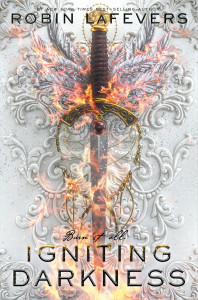
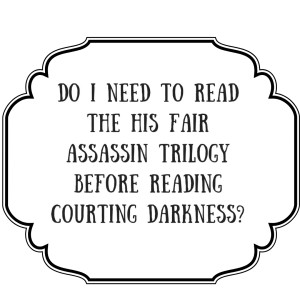
Recent comments